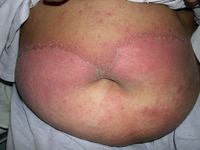Sunday, May 06, 2007
Friday, October 28, 2005
A reddish brown eruption

This 3-month-old infant was born with a generalized mottled eruption
comprised of reddish brown maculopapules. The mother of the infant
reported that the eruption would turn bight red and edematous as the
child cried. There was no family history of atopic diatheses. What
would be the differential diagnosis?
Wednesday, August 31, 2005
How do we differentiate between dominantly inherited and recessively inherited dystrophic epidermolysis bullosa on clinical grounds?
Sunday, June 12, 2005
Linear IgA dermatosis resistent to oral dapsone and steroids

This 4-year-old boy presented with seven month history of developing a vesiculobullous eruption affecting the lower limbs, the buttocks, and the face. Physical examination revealed mutiple clear round vesicles, bullae and erosions on large erythematous back ground. Many of the bullae were arranged to depict string of beads and cluter of jewls signs. Oral mucosa was not involved. A tzank smear and gram stain were negative. Other tests are pending. How would you treat this patient if his condition fails to respond to oral dapsone and steroids?
Ayza Skin Research Center, Lalamusa, Pakistan View more images on Global Skin Atlas
Sunday, June 05, 2005
Generalized lichen planus...what should be the treatment strategy?

Oral Lichen planus. The patient had extensive areas of skin, mucosa and nails involved. An increasing number of generalized LP cases is being reported. I usually ask for anti HCV, but it turns out to be positive in only a few cases. What would be the preferred treatment option for such florid cases? View Images
Monday, May 23, 2005
What causes pitted keratolysis and how would you treat this condition?
How would you manage a case of pitted keratolysis?
Friday, May 13, 2005
How do we manage a case of Sneddon Wilkinson disease resistant to dapsone?
Subcorneal pustular dermatosis also known as Sneddon Wilkinson disease, was first described by Sneddon and Wikinson in 1956. It is rare, benign, chronic relapsing pustular eruption of unknown etiology. The condition which characteristically affects flexural aspects of trunk, has more commonly been reported in middle-aged and elderly women. A background history of paraproteinemia, multiple myeloma, pyoderma gangrenosum, inflammatory bowel disease, or rheumatoid arthritis may be present.
The primary lesions arise within a few hours as flaccid pustules on normal or very mildly erythematous skin. The pustules can be either isolated or grouped, and they tend to coalesce, forming annular, circinate, or serpiginous patterns. The eruption resolves, leaving mild hyperpigmentation, over which further waves of pustulation may arise. The condition is differentiated from acute generalized exanthematous pustulosis and pustular psoraisis by the absence of fever and systemic toxicity.
Most of the cases of subcorneal pustular dermatosis respond to dapsone and topical steroids. What are other treatment options for the cases resistant to the conventional therapy. View image in GSA View Dr.Amor's article in DOJ
Sneddon Wilkinson disease



